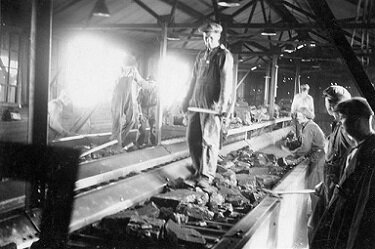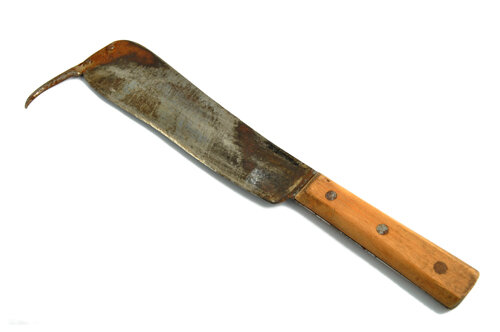Early Pioneers
Takeyasu family (Idosha) in a sugar beet field, topping beets with beet knives, ca 1941-1945. Left to right: Nobuichi (father), Mutsuko (youngest daughter), Shizujo (mother), and Shigeto (son).
Galt Museum & Archives, 19790284005.
Lesson Objectives:
Students will appreciate some of the difficulties the Issei ( first generation of Japanese immigrants) faced when moving to Canada.
Students will understand some of the occupations of early Japanese pioneers.
Students will discover how the Japanese immigrants interacted with people from other cultural communities.
Students will know that Japanese immigrants were among the early immigrants to southern Alberta and Alberta.
Curriculum Connections:
4.2 The Stories, Histories and Peoples of Alberta
4.2.1 Appreciate how an understanding of Alberta’s history, peoples, and stories contribute to their own sense of belonging & identity
Recognize how stories of people and events provide multiple perspectives on past and present events (Identity; Time, Continuity and Change)
4.2.2 Assess, critically, how the cultural and linguistic heritage and diversity of Alberta has evolved over time by exploring and reflecting upon the following questions and issues:
How did the arrival of diverse groups of people determine the establishment and continued growth of rural and urban communities? (Culture and Community; Global Connections; The Land: Places and People)
4.3 Alberta: Celebrations and Challenges
4.3.3 Examine, critically, Alberta’s changing cultural and social dynamics by exploring and reflecting upon the following questions and issues:
In what ways has Alberta changed demographically since 1905?
5.2 Histories and Stories of Ways of Life in Canada
5.2.1 Appreciate the complexity of identity in the Canadian context
Acknowledge the contributions made by diverse cultural groups to the evolution of Canada (Culture and Community; Identity; Time, Continuity and Change)
Recognize how changes in society can affect identity (Culture and Community; Identity)
5.3 Canada: Shaping an Identity
5.3.1 Appreciate how changes impact citizenship and identity
Recognize how economic and political changes impact ways of life of citizens (Citizenship; Economics and Resources; Identity; Power, Authority and Decision Making)
7.2 Following Confederation: Canadian Expansion
7.2.1 Recognize the positive and negative aspects of immigration and migration (Global Connections; The Land: Places and People; Citizenship; Identity)
7.2.2 Recognize the positive and negative consequences of political decisions (Power, Authority and Decision Making)
7.2.5 Evaluate the impact of Confederation and of subsequent immigration to Canada from 1867 to the First World War by exploring and reflecting upon the following questions and issues:
How did Asian immigrants contribute to the development of Canada (i.e., Chinese railway workers)? (Time, Continuity and Change; Culture and Community; The Land: Places and People)
Activities:
Have students read The Issei: Occupations (or read as a class).
Most of the occupations open to Japanese Canadians who arrived in southern Alberta in the early 20th century were very labour intensive and difficult. Throughout the discussions have students think about the limited choice of jobs available to the first Japanese Canadian immigrants.
Show the students the photograph of the beet knife.
Ask them if they have any idea for what the beet knife would be used. They were both used in the sugar beet fields of southern Alberta. Sugar beet is grown to be made into sugar.
Show the students the photograph of the sugar beet field. Below is information related to the type of work that people were required to do in the sugar beet field. Share the information with your students.
One of the first occupations that brought Japanese Canadians to southern Alberta was work in the sugar beet fields. In the early 20th Century, sugar beets required a great deal of labour. Many of the Japanese Canadians who were evacuated to southern Alberta in the 1940s also worked in the sugar beet fields. The work was done by the entire family, including the children. Beet workers, which is what many of the Japanese were, would work for a beet grower, the farmer who owned the land. The beet grower would hire workers for the season to do the labour related to the sugar beets.
In the spring, the beets were seeded. Around June, the beets needed to be “thinned” – during this process, workers removed (sometimes using a hoe but often by hand working on their hands and knees) extra beet plants so the remaining plants were well spaced.
Throughout the summer it was necessary to keep the field free of weeds. Workers would use a garden hoe to weed the entire field throughout the summer.
In fall (often October) would come harvest. If one was lucky, a machine would lift the beets from the ground. Often, though, each beet had to be pulled from the ground by hand. Each harvester was given a beet knife – which was a long knife with a hook at the end. The hook was used to pull the beet from the ground. The harvester would then place the beet on their leg and use the knife to cut off the green top (which was not sent to the factory though could be fed to cattle) from the beet. The beet was then loaded onto wagons or trucks and taken either to the train or directly to the factory. Beet harvest was often a dirty, miserable time done in wind, sometimes cold and snow and until every beet was harvested.
Some Japanese Canadians left after one season in the sugar beet fields in the early 20th century. Others remained and eventually purchased land and became farmers and beet growers themselves.
Have a discussion with the class about work in the sugar beet fields.
How would they have felt doing the work?
Why would people choose to work in the sugar beet fields?
Was it always a choice?
Why do they think Japanese Canadians were recruited by companies for this work?
Another occupation available to early Japanese immigrants was to work in coal mining. Below is information related to the type of work that people were required to do in the coal mines. Share the information with your students.
Share with them the photograph of a coal mine.
In the early days of coal mining, the work was very physical and could be dangerous. In the mines around southern Alberta, over 100 men were killed in 90 years of mining. Around the start of the 19th century, a miner was expected to move approximately 9000 kg of coal in one work day (another way to think about this was that a miner was expected to move ten times his own body weight every fifteen minutes). But many men were willing to work in the mines because it paid relatively well (at least compared to other labour related jobs of the time period).
But for many of the first Japanese Canadians working in the mines, the work of a miner (who often made the most money) was not available to them. Japanese Canadians were often required to work on the above ground work – sorting and packing coal for transport, working around the boilers and cleaning. It took many years before the Japanese Canadians working at the mines were accepted into the unions and given work underground as miners.
What similarities do students notice about Japanese Canadians’ experience in the sugar beet fields and in the coal mines?
What were some of the difficulties that the Issei (first generation of Japanese Canadians) faced as they moved to southern Alberta to look for jobs? Why do you think some of these difficulties existed?
Have students imagine that they are a recent Japanese Canadian immigrant to southern Alberta in the early 20th Century. They have found work either in the sugar beet fields or in the coal mines.
Have each student (or have them work in groups) write a letter home to their families in Japan. Have the students think about how they are going to report about their experiences.
Do they tell their families the truth?
Do they say things are better or worse than they really are?
What do they focus on in the letters?
What do they omit?
Make a logo or symbol based on the pictures of the different occupations that the Japanese pioneers worked in. Students may choose to use a Japanese brush and create the picture using origami paper as a background.



